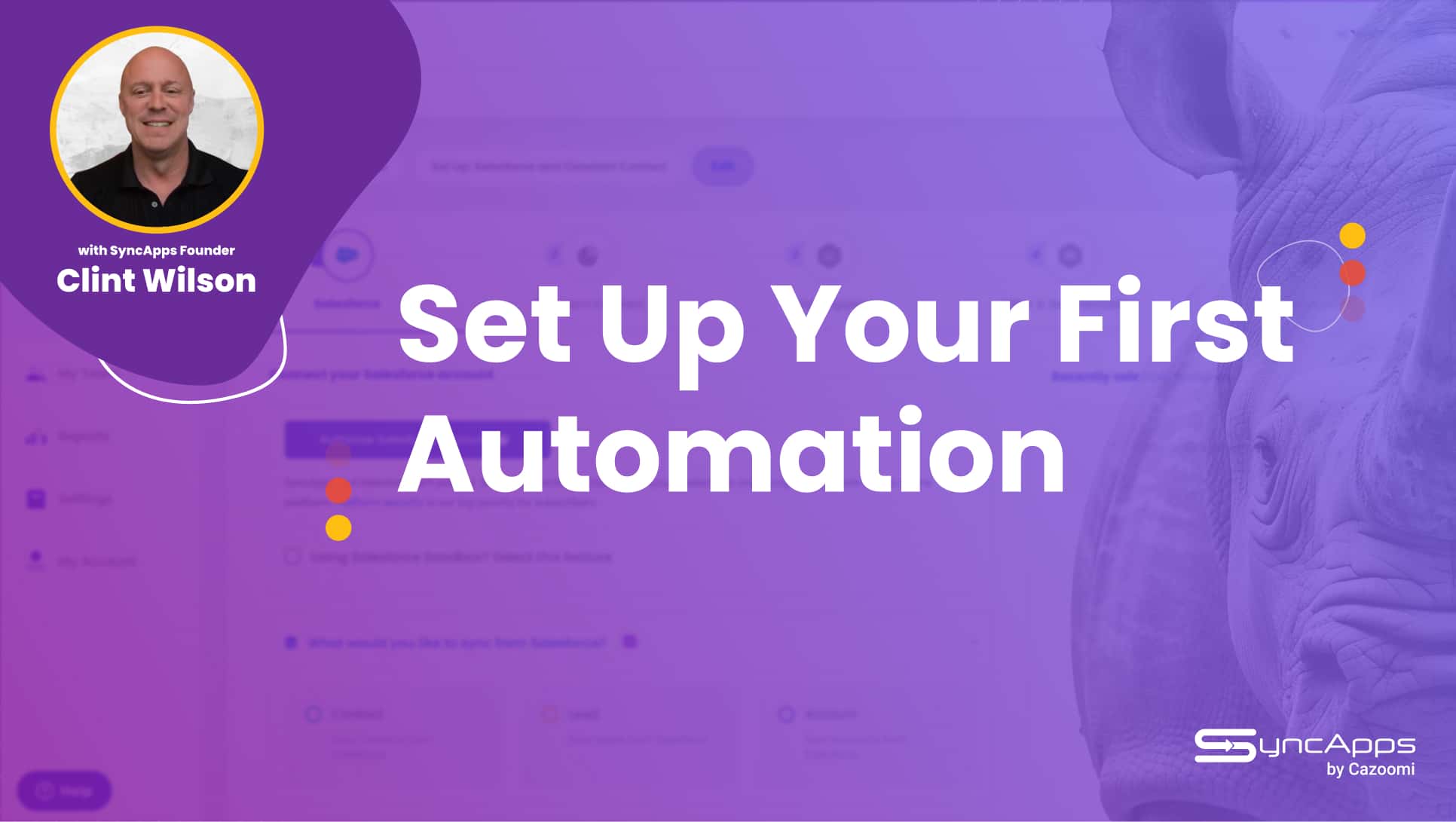What Is Marketing Automation? Examples to Transform Your Approach

What Is Marketing Automation? Examples to Transform Your Approach
Marketing automation is software that handles repetitive marketing tasks automatically. It’s like a digital assistant that never sleeps, helping businesses:
- Send personalized emails based on customer behavior
- Rank and prioritize leads
- Post content on social media
- Target ads to the right audience
Here’s why it matters:
- Companies using automation see a 451% increase in qualified leads
- Nurtured leads spend 47% more than others
- For every $1 spent on automation, businesses see $5.44 return in 3 years
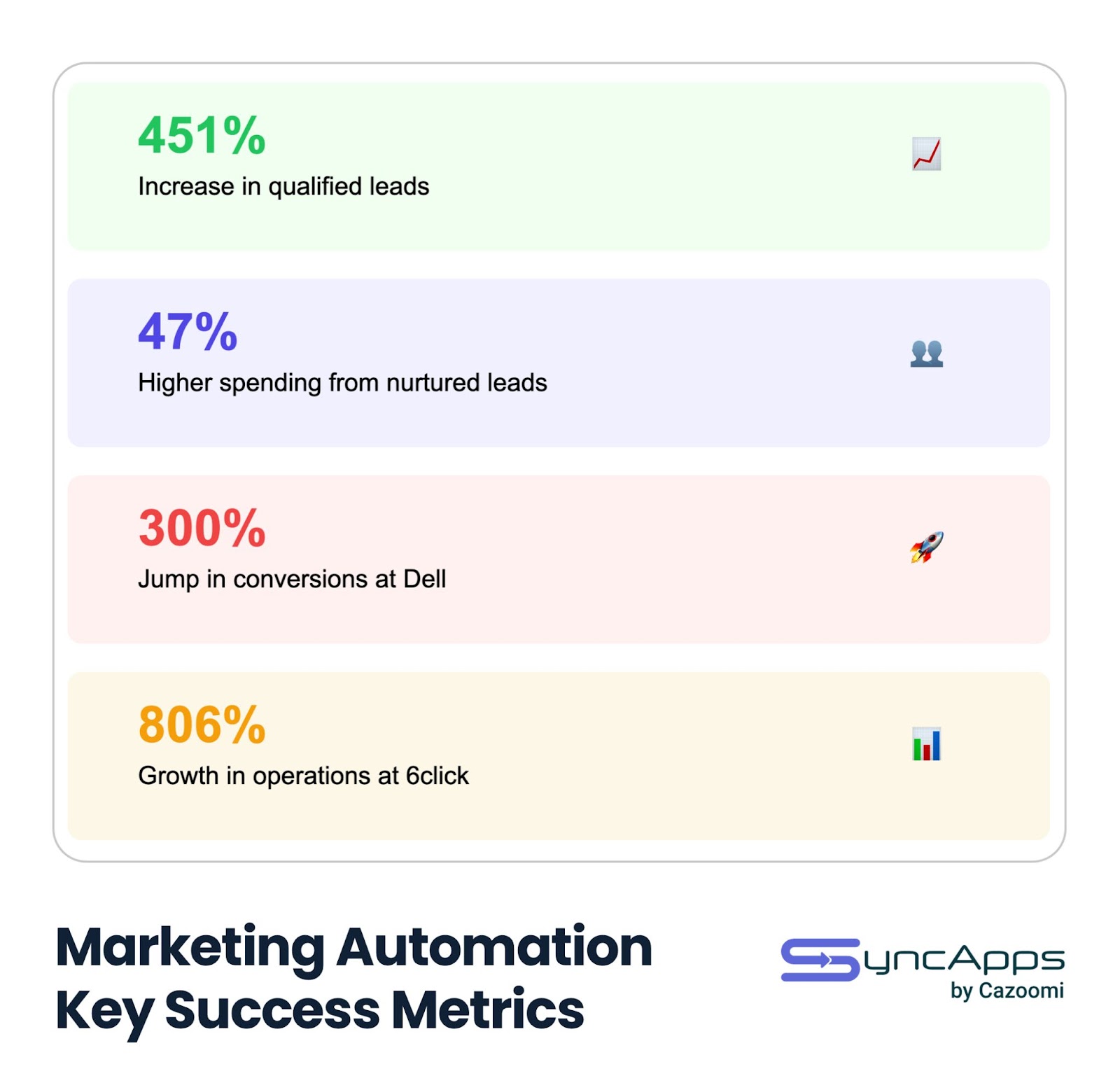
Real-world impact:
- Dell: 70% higher click-through rates, 300% jump in conversions
- 6click: 806% growth in operations
- SkipTheDishes: 50% faster lead onboarding
Key benefits:
- Saves time
- Boosts revenue
- Provides real-time data insights
- Enables personalization at scale
- Creates seamless multi-channel experiences
To get started:
- Choose tools that fit your needs and budget
- Set clear, measurable goals
- Regularly check and improve workflows
- Keep data clean and up-to-date
- Train your team on best practices
What is Marketing Automation?
Main Marketing Automation Tools
Marketing automation tools can supercharge your business. They streamline processes and boost efficiency. Let’s look at the key features that can transform your marketing.
Managing and Growing Leads
At its core, marketing automation is about nurturing leads. Here’s how these tools do it:
Lead Scoring: Tools like Adobe Marketo Engage use AI to analyze lead data. They predict who’s most likely to convert. This helps sales teams focus on hot prospects.
Multi-Channel Lead Capture: Modern platforms grab leads from everywhere. HubSpot, for example, lets you create custom sign-up forms for your website, social media, and emails.
Automated Nurturing: ActiveCampaign shines at behavior-based email sequences. When someone downloads a whitepaper, it kicks off a series of tailored follow-ups.
Connecting Data and Reports
Good marketing needs good data. Here’s how automation tools help:
Centralized Data: Platforms like Salesforce Marketing Cloud pull data from multiple sources. You get a full view of your customers.
Real-Time Analytics: Many tools offer live dashboards. Klaviyo, for instance, shows instant data on email opens, clicks, and conversions.
Custom Reporting: Advanced tools like Oracle Eloqua let you create detailed, custom reports. Track the KPIs that matter to your business.
Here’s a quick look at some popular tools:
| Tool | Best For | Standout Feature | Starting Price |
| HubSpot | All-in-one solution | Wide marketing features + CRM | $800/month |
| ActiveCampaign | AI-driven automation | AI-powered multilingual workflows | $15/month |
| Klaviyo | Easy to use | Drag-and-drop for everything | $20/month |
Pick a tool that fits your needs. Think about your business size, budget, and must-have features when choosing.
How Marketing Systems Work Together
Marketing automation doesn’t work alone. To really step up your game, you need to know how different marketing tools can play nice together. Let’s break it down.
API vs iPaaS: What’s Better
When you’re connecting marketing systems, you’ve got two main options: API connections and iPaaS solutions. Each has its perks, and picking the right one can make or break your marketing strategy.
API Connections: These give you more control and flexibility. They’re perfect if you need something super specific. Think of a big online store connecting their customer database directly to their email tool for super personalized messages.
iPaaS Solutions: Tools like SyncApps make sharing data a breeze, especially if you’re not a tech whiz. They come with ready-made connectors and easy-to-use interfaces.
Here’s a quick look at how they stack up:
| Feature | API Connections | iPaaS Solutions |
| Customization | High | Medium |
| Ease of Use | Needs tech skills | User-friendly |
| Scalability | Can get tricky | Built to grow |
| Cost | Varies | Often subscription |
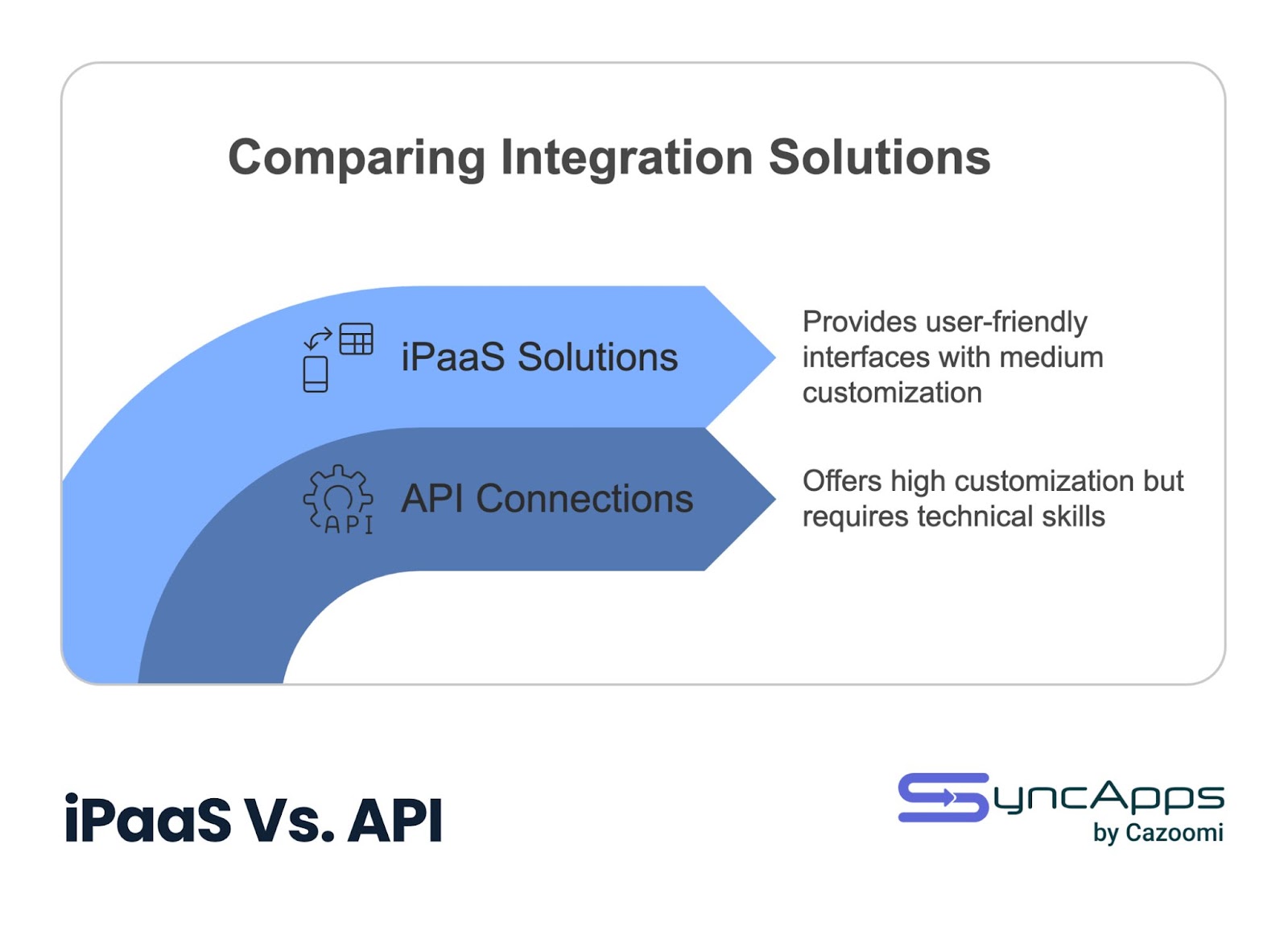
Many companies mix and match. You might use iPaaS for quick, simple connections and APIs for the complex stuff.
Keeping Data Safe and Legal
When you’re linking up your marketing tools, data security is a big deal. It’s not just about protecting your business – it’s about keeping your customers’ trust and following the rules.
Here’s how to keep your data safe and legal:
- Build in Privacy: Think about privacy from the start. It’ll save you headaches later.
- Check Often: Look for weak spots in your connected systems regularly.
- Ask Permission: Make sure you have the OK to use customer data across your tools. This is huge with laws like GDPR and CCPA.
- Less is More: Only collect and share what you really need. As Twilio Segment says, “Your business depends on protecting customer data.”
- Watch Your Partners: If you’re using outside tools, make sure they’re secure too. Your data is only as safe as your weakest link.
Don’t forget, taking data privacy seriously isn’t just about following rules – it can give you an edge. With 86% of US consumers worried about data privacy, showing you care can set you apart.
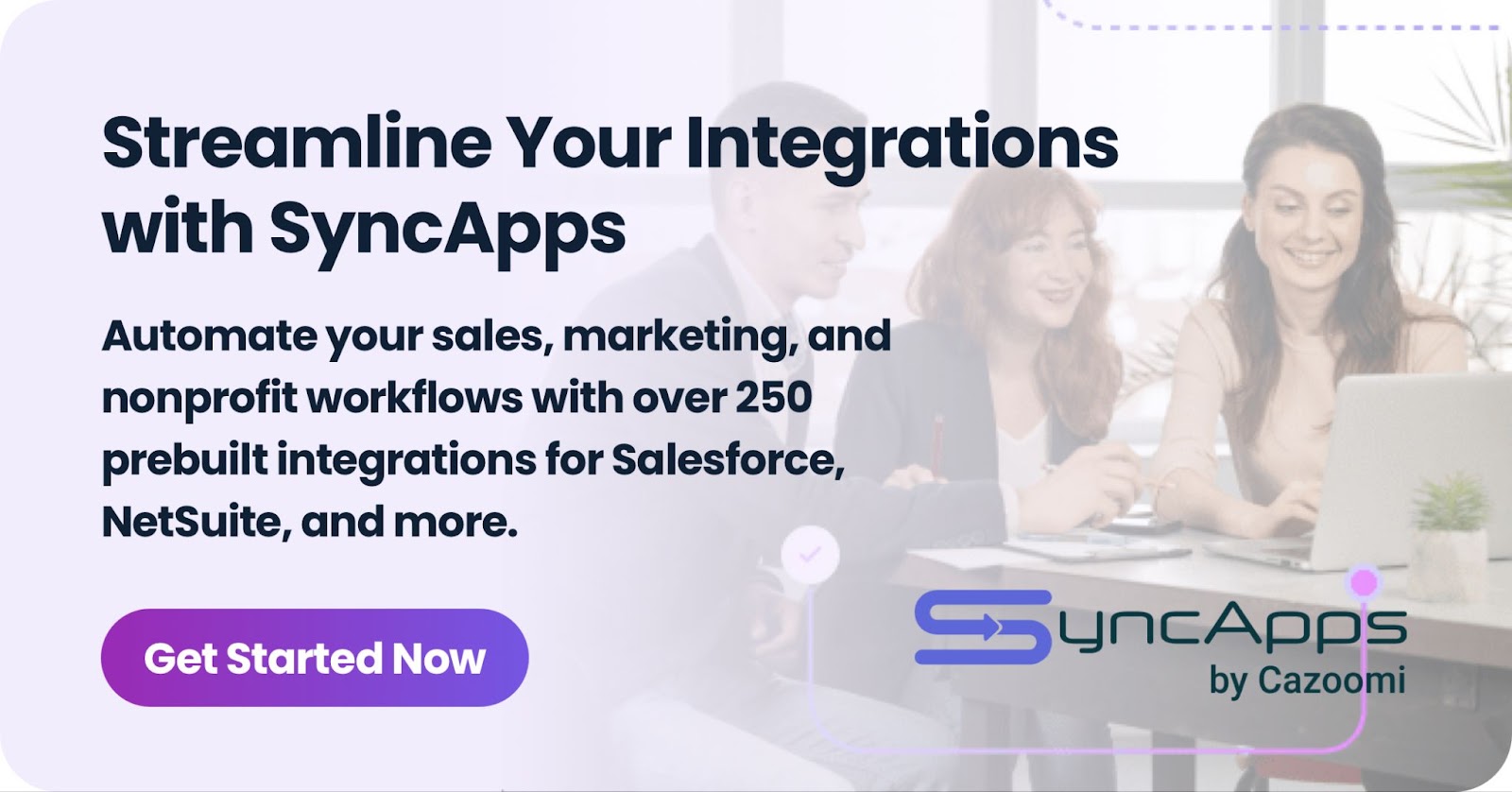
Marketing Automation in Action
Marketing automation isn’t just hype – it’s a game-changer. Let’s look at how real companies are using it to boost their marketing efforts.
Finding New Customers Automatically
Smart businesses use automation to find and nurture leads without constant manual work.
6click’s Growth Explosion
6click, a risk and compliance software company, had a problem: manual sales and onboarding were slowing them down. They turned to HubSpot’s CRM to fix this. The result? A mind-blowing 806% growth in operations. By automating lead capture, nurturing, and onboarding, 6click’s team could focus on big-picture stuff.
“HubSpot’s automation tools have been a game-changer for us. We’ve been able to scale our operations without scaling our team size”, says Anthony Stevens, CEO of 6click.
SkipTheDishes Delivers the Goods
When COVID-19 hit, food delivery service SkipTheDishes had to adapt fast. They used Salesforce’s Sales Cloud and Service Cloud to automate lead management. The payoff was huge:
- Onboarded leads 50% faster
- Generated CAN$ 71 million in rebates
- Added $1.6 million in extra revenue
Automation helped SkipTheDishes handle a surge in demand while keeping service top-notch.
Marketing Across Multiple Channels
Customers interact with brands everywhere these days. Here’s how some companies use automation to create smooth multi-channel experiences:
TestGorilla‘s Clever Funnel
TestGorilla, a pre-employment screening platform, uses a smart multi-channel approach:
1. They start with educational Facebook ads.
2. These ads lead to blog posts about topics like diversity recruiting.
3. After engagement, they follow up with automated emails showcasing their product.
4. They also run targeted Google Ads against competitors to grab high-intent leads.
This automated funnel keeps TestGorilla in customers’ minds from start to finish.
Toggl Hire‘s Content Focus
Toggl Hire takes a different path:
- They create content for high-intent keywords like “toggl hire vs testgorilla”.
- Their blog posts teach potential customers about their product.
- They chat with leads on LinkedIn, building relationships over time.
By automating content distribution and social media engagement, Toggl Hire builds trust in their niche.
Storykit‘s Time-Saving Trick
Video platform Storykit had a problem: too much time on manual tasks. They connected HubSpot with LinkedIn Ads to automate lead scoring and reporting. The result?
- 50% less time spent on lead scoring and reporting
- More effective, data-driven marketing campaigns
Automation handled the number-crunching, so Storykit’s team could focus on creating great content and strategies.
These real examples show that marketing automation isn’t just about saving time – it’s about changing how businesses connect with customers. Whether it’s finding new leads, building relationships across channels, or streamlining operations, automation helps companies of all sizes punch above their weight in marketing.
How to Set Up Marketing Automation
Marketing automation can be a game-changer for your business. It saves time, boosts efficiency, and helps you reach your goals faster. Let’s break down how to get started.
Picking the Right Tools
Choosing the right software is key. Here’s how:
- Know What You Need
What are you trying to do? Nurture leads? Improve emails? Manage social media? Your goals will point you to the right tool.
- Mind Your Budget
Tools come in all price ranges. HubSpot has a free plan to start, while Salesforce Marketing Cloud starts at $1,250 a month. Pick what fits your wallet AND your needs.
- Look at Features
Keep an eye out for:
- Email automation
- Lead scoring
- Social media tools
- Analytics
- Integration options
- Check If It Plays Nice
Make sure the tool works with what you already use. If you’re on Salesforce CRM, Salesforce Marketing Cloud might be a good fit.
- Try Before You Buy
Most platforms offer free trials. Use them! Test the interface and features before you commit.
“Marketing automation is just a tool, and a tool is only as good as the team using it.” – Encharge Team
This quote nails it. The best tool in the world won’t help if your team can’t use it well.
Checking and Improving Results
Once you’re up and running, don’t just sit back. Keep an eye on things:
- Set Clear Goals
Know what you want to achieve. Maybe it’s boosting lead quality by 20% or upping customer engagement by 30%.
- Watch the Numbers
Keep tabs on:
- Conversion rates
- Leads generated
- Cost per lead
- Customer lifetime value
- Analyze and Tweak
Regularly check your workflows. Are they doing what you want? If not, figure out why and fix it.
- Test, Test, Test
Always be testing. Try different email subject lines, content, or send times. See what works best.
- Keep Your Data Clean
Make sure your data is accurate and up-to-date. Do regular data checks.
- Keep Learning
These tools change fast. Keep your team’s skills sharp with ongoing training.
Marketing automation isn’t a “set it and forget it” deal. It needs your attention to really shine. Keep at it, and you’ll see the results.
Wrap-Up
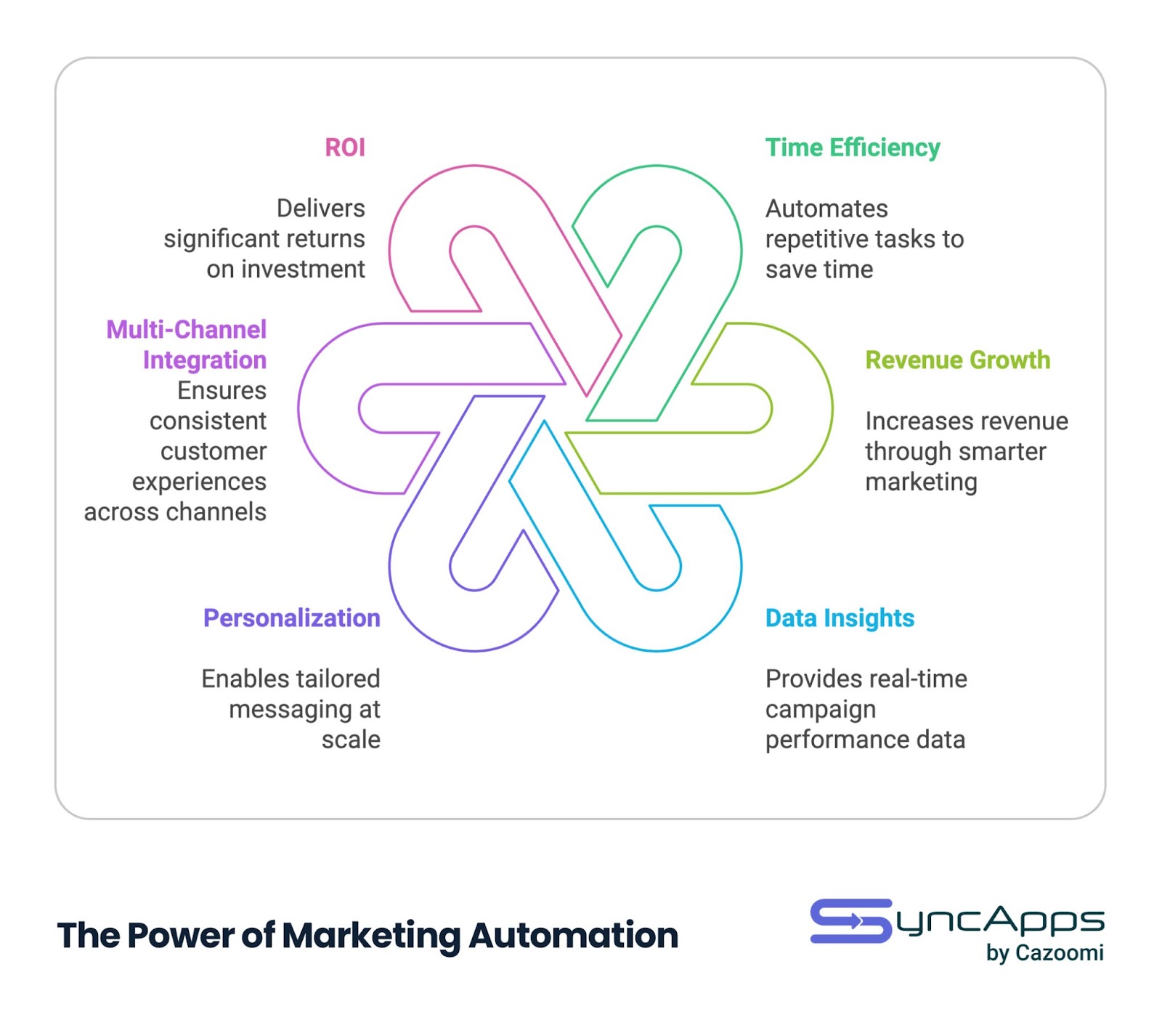
Marketing automation has changed the game for businesses. It’s not just a fancy tool – it’s a powerhouse that can boost your efficiency and drive growth. Let’s break down what we’ve learned:
Time Saver: Marketing automation handles the boring, repetitive stuff. This frees up your team to focus on the creative, strategic work that really matters. Take Roland Corporation, for example. They used ActiveCampaign to automate customer tracking and messaging. The result? Their specialists could give more personalized guidance to potential buyers.
Money Maker: The numbers don’t lie. Companies using marketing automation see their revenue jump by an average of 34%. It’s not about doing more with less – it’s about doing smarter, more targeted marketing that actually converts.
Data Goldmine: With tools like Salesforce Marketing Cloud and Klaviyo, you get real-time insights into how your campaigns are performing. This means you can make quick, smart decisions based on what’s actually working.
Personal Touch at Scale: Marketing automation lets you send the right message to the right person at the right time – even when you’re dealing with thousands of customers. Graza, an olive oil company, uses Klaviyo to send tailored emails to small groups of customers. It’s like having a direct conversation with each one.
Multi-Channel Magic: Today’s customers are everywhere – social media, email, websites. Companies like TestGorilla and Toggl Hire use automation to create smooth experiences across all these channels.
Big Returns: For every dollar spent on marketing automation, companies see an average return of $5.44 in the first three years. And the best part? Most see a return on their investment in less than six months.
“Marketing automation gives you a deep look into what’s working in your marketing efforts.”
This quote sums it up perfectly. It’s not just about saving time – it’s about really understanding your marketing impact and using that knowledge to keep getting better.
We’ve seen some impressive real-world results. 6click grew their operations by 806%. SkipTheDishes onboarded leads 50% faster. The potential is huge. But remember, these tools are just tools. Their effectiveness depends on how well you use them.
To get the most out of marketing automation:
- Pick tools that fit your needs and budget
- Set clear goals you can measure
- Regularly check and improve your automated workflows
- Keep your data clean and up-to-date
- Keep training your team on best practices
Marketing automation isn’t a magic wand, but when used right, it can feel pretty close to magic.
FAQs
What is automation in marketing?
Marketing automation is like having a digital assistant that never sleeps. It’s software that handles routine marketing tasks without you lifting a finger.
Here’s what it can do:
- Send personalized emails based on how customers behave
- Rank leads so you focus on the hot ones
- Post your content on social media
- Show the right ads to the right people
But it’s not just about making your life easier. It’s about supercharging your results.
Get this: companies using automation to nurture leads see a 451% jump in qualified leads. That’s not just growth – that’s like strapping a rocket to your marketing. Now consider that nurtured leads spend 47% more than others – pretty darn productive.
“Marketing automation gives you a deep look into what’s working in your marketing efforts.” – Dan S., Director of Marketing Operations
Want a real-world example? Look at Dell. They used behavior analysis to create ads based on what people were doing on their site and what was in their shopping carts. The result? Click-through rates shot up 70%, and conversions jumped 300%.
That’s the power of marketing automation. It’s not just about doing less work – it’s about getting better results.
marketing automation, lead nurturing, email marketing, data insights, multi-channel marketing, business growth, automation tools



